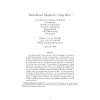Free Online Productivity Tools
i2Speak
i2Symbol
i2OCR
iTex2Img
iWeb2Print
iWeb2Shot
i2Type
iPdf2Split
iPdf2Merge
i2Bopomofo
i2Arabic
i2Style
i2Image
i2PDF
iLatex2Rtf
Sci2ools
ECSQARU
1995
Springer
1995
Springer
Model-Based Diagnostics Using Hints
It is often possible to describe the correct functioning of a system by a mathematical model. As long as observations or measurements correspond to the predictions made by the model, the system may be assumed to be functioning correctly. When, however, a discrepancy arises between the observations and the model-based predictions, then an explanation for this fact has to be found. The foundation of this approach to diagnostics has been laid by Reiter (1987). The explanations generated by his method, called diagnoses, are not unique in general. In addition, they are not weighed by a likelihood measure which would make it possible to compare them. We propose here the theory of hints { an interpretation of the Dempster-Shafer Theory of Evidence { as a very natural and general
Automated Reasoning | Correct Functioning | ECSQARU 1995 | Mathematical Model | Model-based Predictions |
| Added | 26 Aug 2010 |
| Updated | 26 Aug 2010 |
| Type | Conference |
| Year | 1995 |
| Where | ECSQARU |
| Authors | Jürg Kohlas, Paul-André Monney, Rolf Haenni, Norbert Lehmann |
Comments (0)

